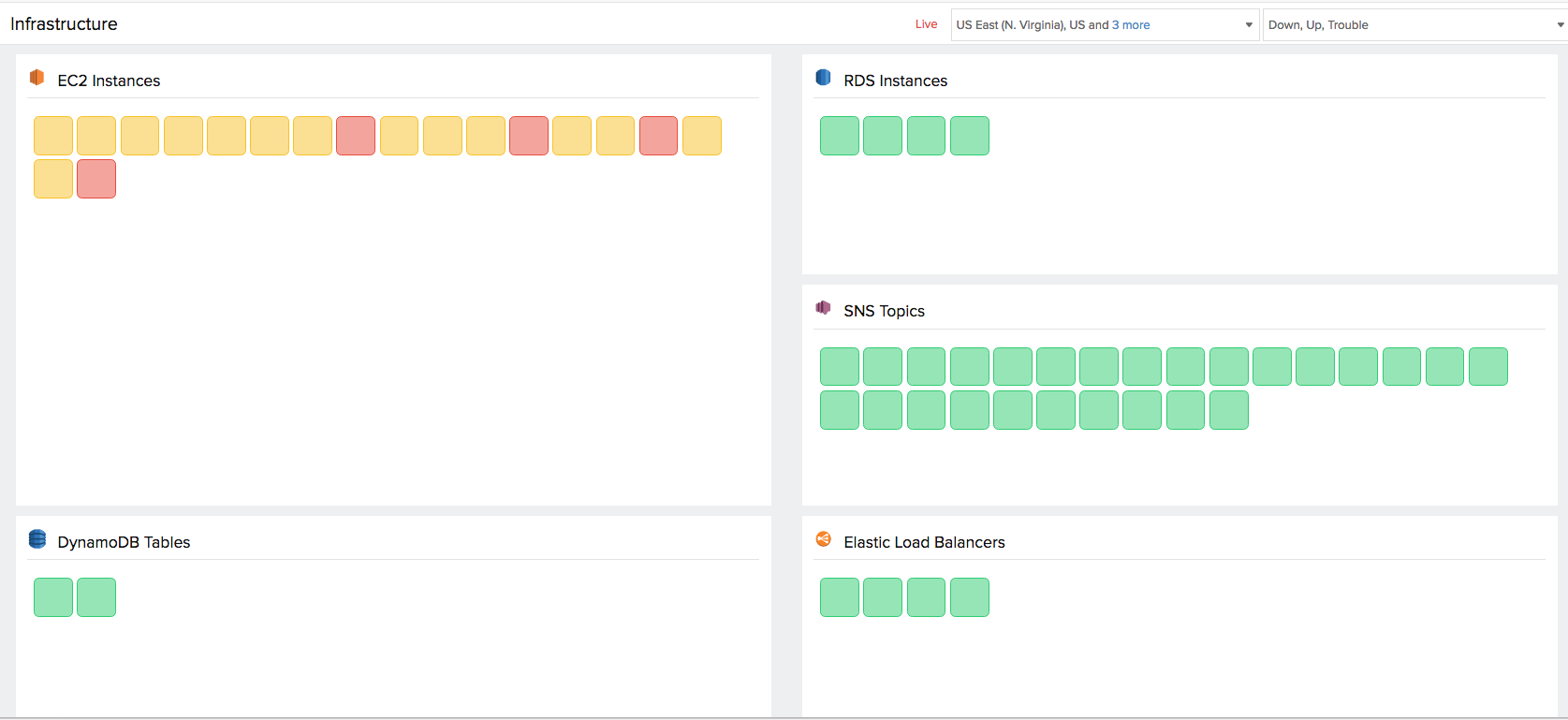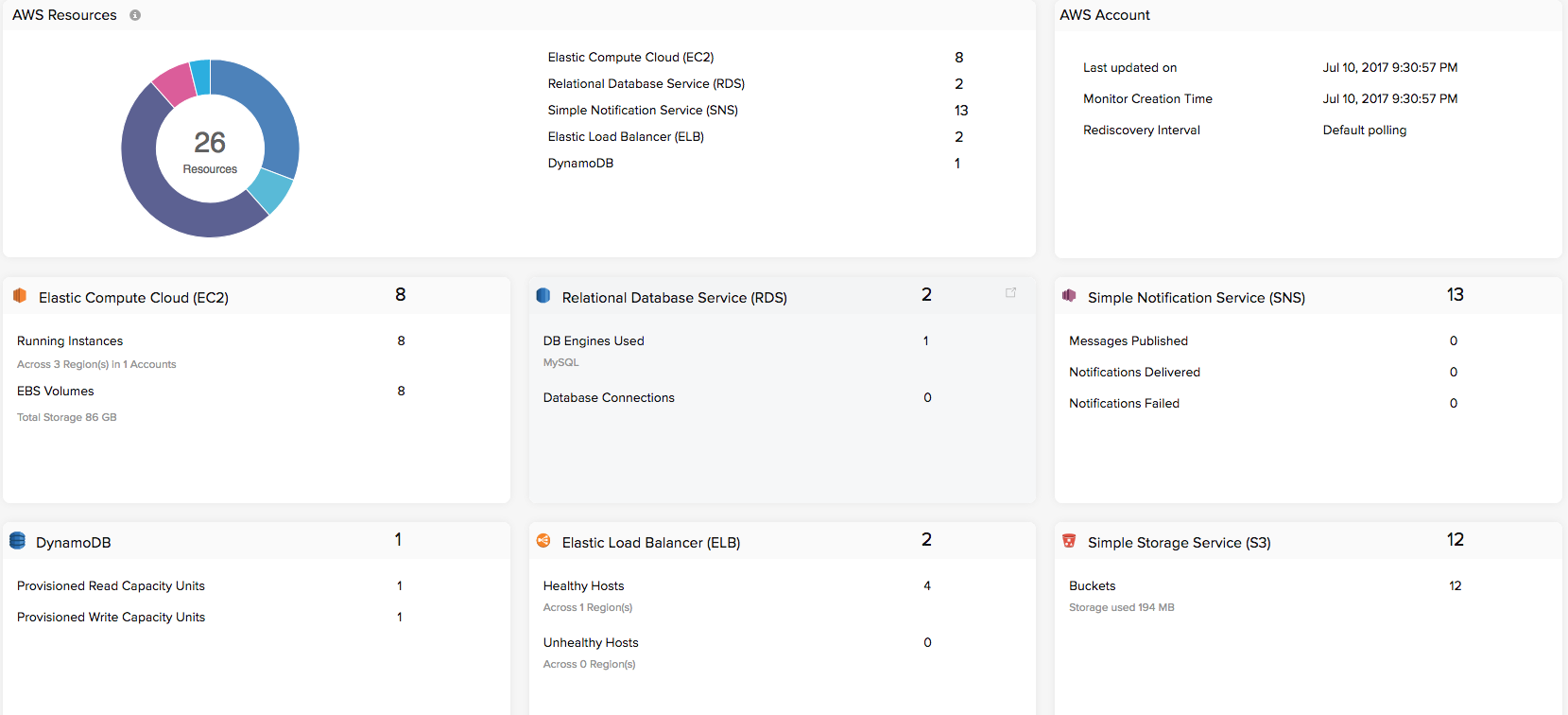Hello folks,
For the past two months, our development team has been hard at work on a number of new features and other AWS related enhancements. Well, today we are officially making them available to all our users. So without wasting time, let's get into the thick of things.
Better visualization
AWS infrastructure dashboard
Visualize the health and performance of all the supported AWS resources that are currently being monitored in your AWS platform in a single bird's eye view. In our infrastructure dashboard UI all your cloud resources, running across different regions are organized based on their underlying service to reduce ambiguity, and each individual instance under the service is represented as a color coded tile.
Status and colors
The overall state of your EC2 instances and other AWS resources are represented by three different health statuses and four additional operational statuses, each with its descriptor, communicating the current state of the resource. Each status also has its unique color. You can also drill down to the respective UI pages of the resource monitor, to get additional information about the outage, by clicking on it. And to add a cherry on top, this view updates the status of your AWS resources in real time.
The very purpose of the AWS infrastructure dashboard is to provide your IT and operations team with an all encompassing view into the health and performance of the various AWS components powering your application in the cloud. So the team which is responsible to keeping your systems up knows immediately when things starts to go wrong.

AWS inventory dashboard
Get improved visibility into your monitored AWS resources. The AWS inventory dashboard automatically collects and displays resource and usage data to help you keep track of your monitored AWS cloud assets with ease. The dashboard will help you answer questions like, what is the type of AWS service? How many instances of that particular service are being monitored? Where is it deployed? You can also view additional metadata and resource configuration information for any cloud resource by drilling down.
The data for the dashboard comes from the both the AWS service level APIs and the CloudWatch APIs. Our automated discovery process sends in requests to the necessary API endpoints at predetermined intervals to capture and store metadata for your monitored AWS resource. The inventory dashboard is our first step towards a new direction, where we want to help AWS cloud natives in optimizing resource utilization, ensuring compliance and cost reduction. So look our for more updates on this front soon.

Help resources
Alerting support for EC2 status checks.
Starting today, for every EC2 instance monitored by Site24x7 alerts for status check failures, instance and system status check for both regular and AutoScaling instance will be enabled by default. Subscription holders (Eval/Paid) who are monitoring their dynamic EC2 environment with Site24x7, can now get alerted on the operational status of each running instance every one minute. If you feel status check failure alerts are not really important, then you can access the EC2 instance threshold profile to turn it off. You can also configure how you want to notified in the event of a status check failure, you can set it up to be notified either as Trouble or Down.
How Site24x7 monitors the status of your instance.
Site24x7 uses the ec2:describe-instance-status API call, to query your EC2 service every one minute, to retrieve information regarding current instance state, ongoing scheduled events, and status check results ? Is the instance OK or is it impaired? Has it failed any one or both of the status checks?.
Previously, every account holder who was monitoring their production cloud servers with Site24x7 had to rely on CloudWatch Alarms and SNS notifications to get notified for instance check failures. If you setup alarms, you had to incur additional charges, if not, then you had to log in to the EC2 management console, select the instance and view the operational status, which was not really practical.
With our latest support, we not only wanted to enhance the coverage of our EC2 monitoring capabilities but also wanted to reduce the dependency that AWS account holders had on CloudWatch alarms. Of course, this feature set is not yet complete without support for EC2 actions. Read along to know more about what we have brought forth in the AWS actions space.

Help resources
EC2 instance monitor threshold profile
AWS service actions
Manually stop and start EC2 instances
Reduce the amount of consumed instance hours for your Amazon Elastic Compute instances by manually stopping and starting instances during nonbusiness and business hours, all from the Site24x7 console itself.
Reboot EC2 instances
You can now reboot an EC2 instance during memory crunch, extensive swapping or in the event of repeated instance check failures right from within the Site24x7 console. The agent deployed across your EC2 instance gives you all the OS level, and application stats you need and our support for EC2 status checks keeps you notified of any failures. This reboot action augments the above data, by giving you more flexibility where instead of just collecting and alerting on utilization stats, you can take the necessary action to remedy the situation.
To authorize Site24x7 to perform actions on your EC2 instances, you need to provide limited write access to the Site24x7 IAM user or to the cross-account IAM role you created between your AWS account and Site24x7's AWS account. The following write level EC2 service actions are required to authenticate the API requests.
ec2:StartInstances
ec2:StopInstances
ec2:RebootInstances
Reboot RDS instances
Site24x7 also supports reboot actions for Amazon RDS instances running MySQL, MariaDB, PostgreSQL, Oracle and SQL Server. The following write level RDS service actions are required to authenticate the API requests.
rds:RebootDBInstance
Manually Stopping, starting your EC2 instances or rebooting your RDS instance is quite simple, all it takes is a couple of clicks in the Site24x7 console. You can also perform these action using our REST APIs. To access actions, select the EC2 or RDS service inventory box from the AWS inventory dashboard UI.

Currently our AWS service actions is a simple management service to help you to take rapid remedy actions and to reduce operational costs. This feature set will only be complete when we bring in support for automatic stop/start schedules and actions based on utilization thresholds. Rest assured our developers are working on this enhancement as we speak. So stay tuned for our next update.
Help resources
Well with that, we are concluding our forum post. The new features and enhancements mentioned above are available off the shelf, if you are already monitoring your AWS account with Site24x7. So take them out for a spin and post your feedback and suggestion in our community. If you have any questions or concerns, please get in touch with our support.